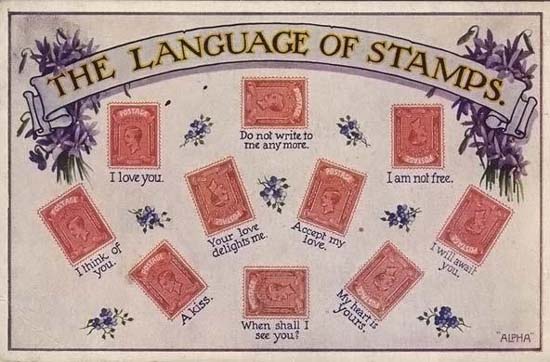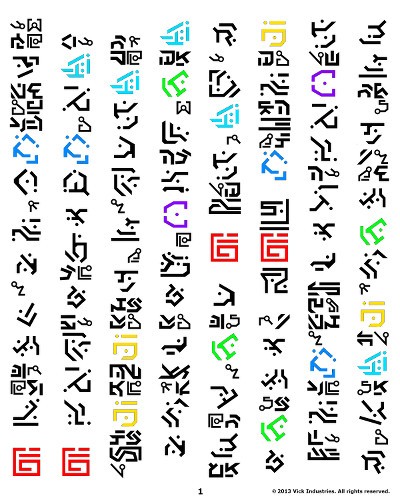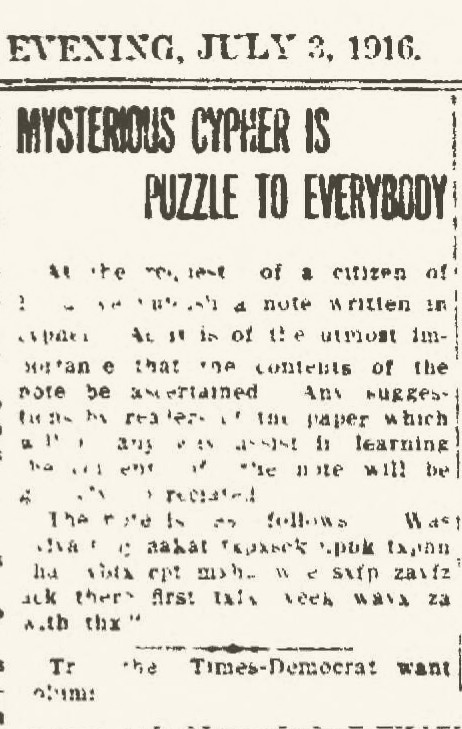Here’s something I stumbled upon recently: a Victorian code world of gloves, handkerchiefs, hats, eyes, parasols and even stamps. Basically, the 1890s saw a craze for flirtation codes, using everyday objects close at hand to signal your romantic intentions and responses. I particularly like the specificity of “I will be at the gate at 8 p.m.”, but I guess that’s just me. 🙂
There were numerous variations of these: usefully, an 1891 edition of the Taranaki Herald (New Plymouth New Zealand) lists several such codes, which I have transcribed below:-
GLOVE FLIRTATION.Holding with tips downward - I wish to be acquainted.
Twirling around the fingers - Be careful! We are watched.
Right hand with the naked thumb exposed - Kiss me.
Left hand with the naked thumb exposed - Do you love me?
Using them as fan - Introduce me to your company.
Smoothing them out gently - I wish I were with you.
Holding them loose in the left hand - Be contented.
Biting the tips - I wish to be rid of you very soon.
Folding up carefully - Get rid of your company.
Striking them over the hand - I am displeased.
Drawing half way on left hand - Indifference.
Clenching them (rolled up) in right hand - No.
Striking over the shoulder - Follow me.
Ends of tips to lips - Do you love me?
Tossing them up gently - I am engaged.
Turning them inside out - I hate you.
Dropping both of them - I love you.
Tapping the chin - I love another.
Putting them away - I'm vexed.
Dropping one of them - Yes.HANDKERCHIEF FLIRTATION.
Drawing across the lips - Desirous of an acquaintance.
Drawing across the eyes - I am sorry.
Taking it by the centre - You are willing.
Dropping - We will be friends!
Twirling in both hands - Indifference.
Drawing across the cheek - I love you.
Drawing through the hands - I hate you.
Letting it rest on the right cheek - Yes.
Letting it rest on the left cheek - No.
Twisting in the left hand - I wish to be rid of you.
Twisting in the right hand - I love another.
Folding it - I wish to speak with you.
Over the shoulder - Follow me.
Opposite corners in both hands - Wait for me.
Drawing across the forehead - We are watched.
Placing on the right ear - You have changed.
Letting it remain on the eyes - You are cruel.
Winding around the forefinger - I am engaged.
Winding around the third finger - I am married.
Putting in the pocket - No more at present.PARASOL FLIRTATION.
Carrying it elevated in left hand - Desiring acquaintance.
Carrying elevated in right hand - You're too willing.
Carrying closed in left hand, by side - Follow me.
Carrying in front of you - No more at present.
Carrying over shoulder - You are too cruel.
Closing it up - I wish to speak with you.
Dropping it - I love you.
Folding it up - Get rid of your company.
Letting it rest on the left cheek - No.
Letting it rest on the right cheek - Yes.
Striking on hand - I am much displeased.
Swinging it to and fro by the handle on the right side - I am married.
Swinging same on left side - I am engaged.
Tapping the chin - I am in love with another.
Twirling it around - We are watched.
Using as a fan - Introduce me to your company.
With handle to lips - Kiss me.
Putting away - No more at present.FAN FLIRTATION.
Carrying right hand in front of face - Follow me.
Carrying in left hand - Desirous of an acquaintance.
Placing it on the right ear - You have changed.
Twirling it in left hand - I wish to get rid of you.
Drawing across forehead - We are watched.
Carrying in right hand - You are too willing.
Drawing through the hand - I hate you.
Twirling in right hand - I love another.
Drawing across the cheek - I love you.
Closing it - I wish to speak to you.
Drawing across the eye - I am sorry.
Letting it rest on right cheek - Yes.
Letting it rest on left cheek - No.
Open and shut - You are cruel.
Dropping - We will be friends.
Fanning slow - I am married.
Fanning fast - I am engaged.
With handle to lips - Kiss me.
Shut - You have changed.
Open wide - Wait for me.HAT FLIRTATION.
Carrying it in the right hand - Desirous of an acquaintance.
Carrying it in the left hand - I hate you!
Running the finger around the crown - I love you.
Running the hand around the rim - I hate you.
To wear on the right side of the head - No.
To wear on the left side of the head - Yes.
To wear on the back of the head — I wish to speak with you.
To incline towards the nose — We are watched.
Putting it behind you — I am married.
Putting it in front of you — I am single.
Carrying in the band by the crown — Follow me.
Putting it under the right arm — Wait for me.
Putting it under the left arm — I will be at the gate at 8 p.m.
Putting the hat on the head straight — All for the present.EYE FLIRTATION.
Winking the right eye - I love you.
Winking the left eye - I hate you.
Winking both eyes - Yes.
Winking both eyes at once - We are watched.
Winking right eye twice - I am engaged.
Winking left eye twice - I am married.
Dropping the eyelids - May I kiss you?
Raising the eyebrows - Kiss me.
Closing the left eye slowly - Try and love me.
Closing the right eye slowly - You are beautiful.
Placing right forefinger to right eye - Do you love me?
Placing right forefinger to left eye - You are handsome.
Placing right little finger to the right eye - Aren't you ashamed?
All of which is a lot like all the foolishly faked-up floriography that Victorians loved so much: but why say it with flowers when you can say it with a fan?
Anyway, I have to say that these promenading picayunes pale into paltriness compared with something else I found in the same web-trawling session: the (frankly astonishing) secret world of stamp codes.
You’ve already guessed when these flourished (same as above), what they said (same as above) and how they worked (same as above): all I can add is that here’s a link to a truly epic webpage devoted to a whole variety of stamp codes, highly recommended. Fabulous stuff… enjoy! 🙂




